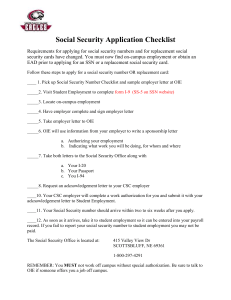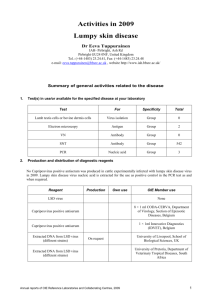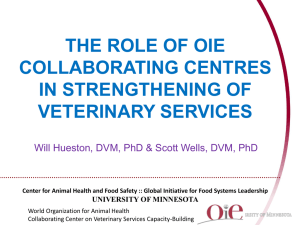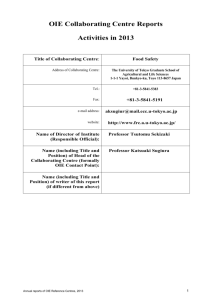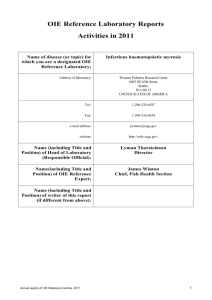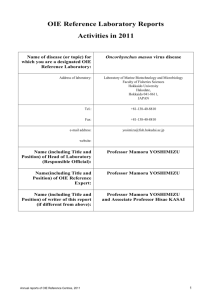OIE Collaborating Centre Reports Activities in 2013
advertisement
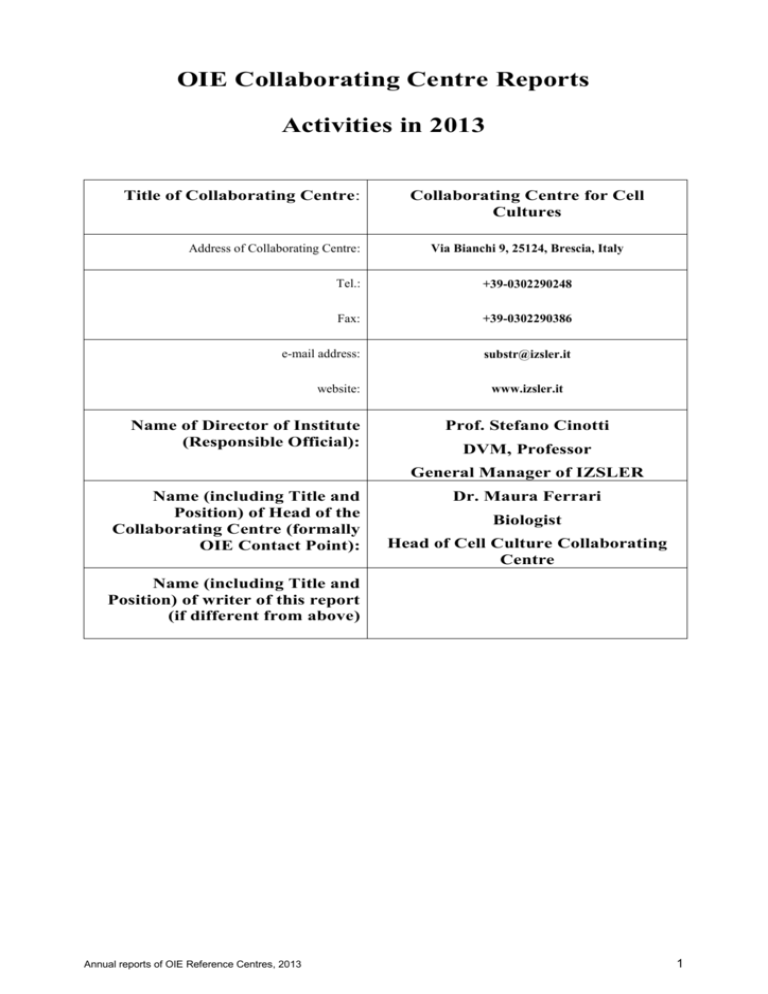
OIE Collaborating Centre Reports Activities in 2013 Title of Collaborating Centre: Address of Collaborating Centre: Collaborating Centre for Cell Cultures Via Bianchi 9, 25124, Brescia, Italy Tel.: +39-0302290248 Fax: +39-0302290386 e-mail address: substr@izsler.it website: Name of Director of Institute (Responsible Official): www.izsler.it Prof. Stefano Cinotti DVM, Professor General Manager of IZSLER Name (including Title and Position) of Head of the Collaborating Centre (formally OIE Contact Point): Dr. Maura Ferrari Biologist Head of Cell Culture Collaborating Centre Name (including Title and Position) of writer of this report (if different from above) Annual reports of OIE Reference Centres, 2013 1 Cell Cultures Summary of activities specifically related to the mandate of OIE Collaborating Centres ToR: To provide services to the OIE, in particular within the region, in the designated specialty, in support of the implementation of OIE policies and, where required, seek for collaboration with OIE Reference Laboratories ToR: To identify and maintain existing expertise, in particular within its region 1. Activities as a centre of research, expertise, standardisation and dissemination of techniques within the remit of the mandate given by the OIE Disease control Epidemiology, surveillance, risk assessment, modelling Training, capacity building Zoonoses Wildlife Avian diseases Aquatic animal diseases Animal welfare Diagnosis, biotechnology and laboratory Veterinary medicinal products Vaccines Food safety Feed safety Other (Name the category: Cell cultures and their application for diagnosis, research, therapy, production and new in vitro tests) DIAGNOSIS, BIOTECHNOLOGY AND LABORATORY Title of activity Scope Basic activity : preparation, amplification, control, use and distribution of the different types of cell cultures obtained from different sources Maintain and increase the cell culture types to be used in the different fields of Scientific Community for diagnosis, reasearch and production of viruses from different species. Preparaton of reference standards for controls of cells used in production of biologicals, including vaccines. In 2013 the collection has resulted to be composed by the following cell types: Total No. of : normal established cell lines No. 224 tumour established cell lines No. 247 hybridomas No. 61 primary cell cultures No. 65 animal Mesenchymal Stromal Cells No. 26 Cell types: total number 623 Frozen cell vials: number 49,642 Cells that have been distributed: number 336 New Organizations New Organizations that have requested cells to the OIE Collaborating Centre: number 13 of which 8 national and 5 international (Singapore, United Kingdom, France, Austria, Philippines); In total 809 are the organizations that over the years have requested cells to OIE Collaborating Centre. 675 of them are national; 121 are of other countries 2 Annual reports of OIE Reference Centres, 2013 Cell Cultures Other: Title of activity Scope Detection of extraneous agents by cell culture isolation. Testing of pharmaceutical products, viral vaccines, cells used for vaccine production, mesenchymal stromal cells used for therapy, cells used in virology laboratories in order to ensure their purity. Validation of production steps. Evaluation of the efficacy of cleaning, disinfection and sterilization procedures to inhibt virus replication. These tests are carried out according to international guidelines Quality controls To ensure the characteristics, identity and purity of the the cell cultures and based on testing methods to evaluate microbiological , mycoplasma and virus contamination. Oncogenic features are also evaluated to ensure the safety of cells used for production of vaccines and biologicals. All testing methods are in accordance to European Pharmacopeia and performed according to quality management system (ISO IEC 17025) Preparation and amplification of new cell cultures Research activity To increase the cell culture collection with the aim to offer a wider possibility of use (isolation of novel virus, development of new serological tests, employment in new fields etc) It was based on the studies made according to reasearch projects approved with three main different strategies: 1) to improve knowlwdges on the therapeutic application of Mesenchymal Stromal Cells in animals; 2) to develop new testing methods for virus detection and for evaluation of other quality parameters; 3) to develop new in vitro tests to be used as alternative to in vivo experiments conducted on animals. ToR: To propose or develop methods and procedures that facilitate harmonisation of international standards and guidelines applicable to the designated specialty 2. Proposal or development of any procedure that will facilitate harmonisation of international regulations applicable to the surveillance and control of animal diseases, food safety or animal welfare Proposal title Scope/Content Applicable area Development of new testing methods To ensure the purity, safety, and authentity of cell cultures, avoiding to obtain not corrct results regarding testing methods / production / research carried out with cells of no proper quality parameters. Surveillance and control of animal diseases Reference number of the test: 02/308 Food safety Animal welfare Other Testing methods developed in 2013: Evaluation of cell cultures origin by isoenzyme analysis (Authentikit™ Annual reports of OIE Reference Centres, 2013 3 Cell Cultures Proposal title Scope/Content Applicable area system, Innovative Chemistry) 02/309 Evaluation of the growth efficiency of animal serum 02/310 Evaluation of the transformed features of cell cultures by in vitro test 02/311 Tumorigenicity of cell cultures by in vivo test 02/328 Evaluation of mesenchymal stromal cells differentiation capacity toward adipocites 02/329 02/330 02/364 02/365 04/099 04/117 Evaluation of mesenchymal stromal cells differentiation capacity toward chondrocytes Evaluation of mesenchymal stromal cells differentiation capacity towards osteoblasts Evaluation of bacterial endotoxin levels in biological and pharmaceutical products Biological evaluation of medical devices by in vitro cytotoxicity assay (MTT) Detection of anti-PRRSV antibodies by serum neutralization 05/26 Detection of adventitious viruses in biological/pharmaceutical products in cell culture 09/171 Detection of human cytomegalovirus (HCMV) in biological/pharmaceutical products by PCR real-time (kit “Artus® CMV RG PCR”) 09/172 Detection of Epstein-Barr virus (EBV) in biological/pharmaceutical products by PCR real-time (KIT “Artus® EBV RG PCR”) 09/173 09/174 09/175 Detection of Hepatitis B virus (HBV) in biological/pharmaceutical products by PCR real-time (KIT “Artus® HBV RG PCR”) Detection of Hepatitis C virus (HCV) in biological/pharmaceutical products by RT-PCR real-time (KIT “Artus® HCV RG RT-PCR”) Detection of herpes simplex virus (HSV) type 1 and type 2 in biological/pharmaceutical products by PCR real-time (KIT “Artus® HSV1/2 RG PCR”) Detection of human immunodeficiency virus (HIV) in 4 Annual reports of OIE Reference Centres, 2013 Cell Cultures Proposal title Scope/Content 09/177 cell culture and reagents by RT-PCR real-time (KIT “Artus® HI Virus-1 RG RT-PCR”) 09/189 Detection of human chondrocytes molecular expression markers (link protein and aggrecan) in pharmaceutical products by PCR 09/190 Detection of Swine Classical fever (SCF) in biological and pharmaceutical products by PCR Real-Time 09/191 Standardization of the procedures regarding all steps involved in cell culture field Applicable area Detection of swine parvovirus (PPV) in biological and pharmaceutical products by PCR Real-Time The flow chart of the cell culture preparation, cultivation, control and storage is approved by the quality management system and it allows to trace each step of the process. The final product must have high quality parameters and, if possible, its range of application must be evaluated (for instance virus isolation, serological tests, in vitro alternative methods, etc) ToR: To establish and maintain a network with other OIE Collaborating Centres designated for the same specialty, and should the need arise, with Collaborating Centres in other disciplines ToR: To carry out and/or coordinate scientific and technical studies in collaboration with other centres, laboratories or organisations 3. Did your Collaborating Centre maintain a network with other OIE Collaborating Centres (CC), Reference Laboratories (RL), or organisations designated for the same specialty, to coordinate scientific and technical studies? Yes Name of OIE CC/RL/other organisation(s) No Location Region of networking Centre Purpose Centre de Recerca en Sanitad Animal, CReSa, campus UAB Barcelona (Spain) Africa Americas Asia and Pacific Europe Middle East to identify cell lines able to allow Porcine reproductive and Respiratory Syndrome Virus – PRRSV isolation from target tissues of infected animals OIE Reference Laboratory for Avian influenza and Newcastle disease Padova, Italy Africa Americas Asia and Pacific Europe Middle East to develope of expertise and standardization of the cell culture for use in virology field; use of cell lines as alternative to chichen embryos for virus isolation and amplification Annual reports of OIE Reference Centres, 2013 5 Cell Cultures Name of OIE CC/RL/other organisation(s) 4. Region of networking Centre Location Animal Health and Veterinary Laboratories Agency (AHVLA) Surrey, UK OIE Reference Laboratory for swine influenza IZSLER Parma, Italy Africa Americas Asia and Pacific Europe Middle East to develope of expertise and standardization of the cell culture for use in virology field; use of cell lines as alternative to chichen embryos for virus isolation and amplification Africa Americas Asia and Pacific Europe Middle East to develope of expertise and standardization of the cell culture for use in virology field; use of cell lines as alternative to chichen embryos for virus isolation and amplification Did your Collaborating Centre maintain a network with other OIE Collaborating Centres, Reference laboratories, or organisations in other disciplines, to coordinate scientific and technical studies? Yes Name of OIE CC/RL/other organisation(s) The National Centre for the Replacement, Refinement and Reduction of Animals in Research (NC3Rs) No Location London United Kingdom Region of networking Centre Purpose Africa Americas Asia and Pacific Europe Middle East Coooperation in the translation in italian language of the ARRIVE guidelines used to improve the procedures of in vivo experiments; their disclosure to Organizations involved in this fields National Reference Centre for Classical and African swine fever IZS Perugia, Italy Africa Americas Asia and Pacific Europe Middle East Cooperation in suggesting cell lines to be used for virus isolation and cultivation Istituto Zooprofilattico Sperimentale dell’Abruzzo e del Molise: Reference Centre for bluetongue virus IZS Teramo, Italy Africa Americas Asia and Pacific Europe Middle East Involved for field sera biobanking toward bluetongue The Roslin Institute, University of Edinburgh, (Prof. Tahar Ait-Ali) Edinburgh Africa Americas Asia and Pacific Europe Middle East National Veterinary Research Institute, Department of Swine Diseases OIE Reference Laboratory for PRRS. (Dr. Tomasz Stadejek) University of NebraskaLincoln, School of Veterinary and Biomedical Sciences (Prof. Fernando Osorio) 6 Purpose UK Warsaw Polond Nebraska Africa Americas Asia and Pacific Europe Middle East Africa Americas Asia and Pacific Europe Middle East Cost Action: viruses related to swine respiratory disease with particular reference to PRRS Cooperation in pathogenetic studies on PRRRSV virus infection in pigs Annual reports of OIE Reference Centres, 2013 Cell Cultures ToR: To place expert consultants at the disposal of the OIE. 5. Did your Collaborating Centre place expert consultants at the disposal of the OIE? Yes No Name of expert Kind of consultancy Subject Dr Maura Ferrari Author of chapter Author of Chapter of Molecular Diagnostics in Laboratory Veterinary Practice (in preparation) Dr. Maura Ferrari Co-author of chapter Detection of Neutralizing Antibodies in Pigs Inoculated with an Inactivated Vaccine Against Porcine Circovirus Type 2 (PCV2) ToR: To provide, within the designated specialty, scientific and technical training to personnel from OIE Member Countries 6. Did your Collaborating Centre provide scientific and technical training, within the remit of the mandate given by the OIE, to personnel from OIE Member Countries? Yes No If the answer is yes, please provide the total number of trained persons for each of the following categories: a) Technical visits: ................................................................ 2 b) Seminars: ......................................................................... c) Hands-on training courses: .............................................. d) Internships (>1 month): ................................................... ToR: To organise and participate in scientific meetings and other activities on behalf of the OIE 7. Did your Collaborating Centre organise or participate in the organisation of scientific meetings on behalf of the OIE? Yes No ToR: To collect, process, analyse, publish and disseminate data and information relevant to the designated specialty 8. Publication and dissemination of any information within the remit of the mandate given by the OIE that may be useful to Member Countries of the OIE (Indicate in the appropriate box the number by category) a) Articles published in peer-reviewed journals: ................. 6 Renzi S, Riccò S, Dotti S, Sesso L, Grolli S, Cornali M, Carlin S, Patruno M, Cinotti S, and Ferrari M. (2013). Autologous bone marrow mesenchymal stromal cells for regeneration of injured equine ligaments and tendons: a clinical report. Res. Vet. Sci., 95 (1), 272-7. Annual reports of OIE Reference Centres, 2013 7 Cell Cultures Dotti S, Guadagnini G, Salvini F, Razzuoli E, Ferrari M, Alborali Gl, Amadori M. (2013). Time-course of antibody and cell-mediated immune responses to porcine Reproductive and Respiratory syndrome virus under field conditions. Res Vet Sci., 94, 510-517. Riccò S, Renzi S, Delbue M, Conti V, Merli E, Ramoni R, Lucarelli E, Gnudi G, Ferrari M, Grolli S. (2013). Allogenic adipose tissue-derived mesenchymal stem cells in combination with platelet rich plasma are safe and effective in the therapy of superficial digital flexor tendonitis in the horse. Int J Immunopathol Pharmacol. 26, 61-68. Petrini S, Paniccià M, Silenzi V, Ciuti F, Bresaola M, Fortunati M, Perugini G, De Mia GM, perugini G, Ferrari M,, 2013. Detection of neutralizing antibodies in pigs inoculated with an inactivated vaccine against porcine Circovirus type 2 (PCV2). Trends in veterinary sciences: current aspects in veterinary morphophysiology, biochemistry, animal production, food hygiene and clinical sciences. C. Boiti et al. (eds.), Trends in Veterinary Sciences, DOI: 10.1007/978-3-642-36488-4_12, Springer-Verlag, 63-66. Petrini S, Silenzi V, Manuali E, Paniccià M, Sensi M, Fortunati M, Feliziani F, Ferrari M, De Mia GM, 2013. Association of the main viral pathogens with Porcine Respiratory Disease Complex (PRDC) in Central Italy. Journal of Veterinary Diagnostic Investigation DOI 10.1007/s11259-013-9552-3, Vet Res Commun (2013) 37:251–257 Petrini S, Ramadori G, Villa R, Borghetti P, De Angelis E, Cantoni AM, Corradi A, Amici A, Ferrari M, 2013. Evaluation of Different DNA Vaccines against Porcine Reproductive and Respiratory Syndrome (PRRS) in Pigs. doi:10.3390/vaccines1040463. Vaccines 2013, 1, 463-480. b) International conference presentations: ......................... 3 1) Time-course of antibody and cell-mediated immune responses to porcine reproductive and respiratory syndrome virus under field conditions. 10th International Veterinary Immunology Symposium (IVIS) : 28th August -1 St September 2013 Milan, Italy An Italian Biobanking of Veterinary Resources at IZSLER. 7TH Epizone Annual Meeting : 1 - 4 October 2013, Bruxel, Belgium 2) Biobanking of animal Mesenchymal Stromal Cells and quality controls for a safe therapeutic application.European Society Biopreservation and Biobanking (ESBB )Annual Meeting. 8 - 11 October 2013, Verona, Italy 3) Mesenchymal stromal cells (MSCs) alteration following in vitro amplification. Advances in In-Vitro Cell and Tissue Culture and 5th Annual Quasi-Vivo® User Group Meeting. 21 - 22 May 2013, Liverpool, United Kingdom c) National conference presentations: ................................ 5 1) Characterization of limbal cells and mesenchymal stromal cells (MSC) isolated from adipose tissue. Annual Meeting ONLUS-AICC Stem Cell Research Italy International Society For Cellular Therapy. 2022 November 2013, Brescia, Italy. 2) The activity performed by Cell Culture Centre with mesenchymal stromal cells in toxicology field. Italian Pltform on Alternative Methods (IPAM). Annual Meeting. Toxicology and stem cells.14 November 2013, Brescia, Italy. 3) Molecular changes associated with adaptation of avian influenza virus in embryonated chicken eggs and in cell cultures. LXVII National Congress (Italian Society of Veterinary Sciences (S.I.S.Vet). 17-18-19 September 2013, Brescia, Italy. 4) Mesenchymal stromal cells: a promising tool in veterinary medicine.IV National Congress of Stem Cell Research Society. 27-28-29 June 2013, Brescia, Italy. 5) Italian Reference Centre of Alternative Methods: activity and research for medical device. Meeting on Alternative methods: 3Rs, research and regulatory aspects. 17-19 April 2013, Brescia, Italy 8 Annual reports of OIE Reference Centres, 2013 Cell Cultures d) Other: ............................................................................... 2 Two meetings organized by the Cell Culture Collaborating Centre are below reported (www.izsler.it) 1) AICC–GISM 4th International Satellite Symposium. 20-22 November 2013, Brescia, Italy 2) Alternative methods: 3Rs, research and regulatory aspects. 17-19 April 2013, Brescia, Italy. _______________ Annual reports of OIE Reference Centres, 2013 9
